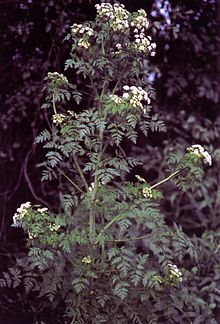Conium maculatum
| Conium maculatum | |
|---|---|

| |
| Conium maculatum in California | |
| Scientific classification | |
| Kingdom: | Plantae |
| Clade: | Tracheophytes |
| Clade: | Angiosperms |
| Clade: | Eudicots |
| Clade: | Asterids |
| Order: | Apiales |
| Family: | Apiaceae |
| Genus: | Conium |
| Species: | C. maculatum
|
| Binomial name | |
| Conium maculatum L., 1753
| |
| Synonyms[1] | |
|
List
| |
Conium maculatum, known as hemlock (British English),[2] or poison hemlock (American English)[3] is a highly poisonous flowering plant in the carrot family Apiaceae, native to Europe and North Africa. It is herbaceous without woody parts and has a biennial lifecycle. A hardy plant capable of living in a variety of environments, hemlock is widely naturalised in locations outside its native range, such as parts of Australia, West Asia, and North and South America, to which it has been introduced. It is capable of spreading and thereby becoming an invasive weed.
All parts of the plant are toxic, especially the seeds and roots, and especially when ingested. Under the right conditions the plant grows quite rapidly during the growing season and can reach heights of 2.4 metres (8 feet), with a long penetrating root. The plant has a distinctive odour usually considered unpleasant that carries with the wind. The hollow stems are usually spotted with a dark maroon colour and become dry and brown after completing its biennial lifecycle. The hollow stems of the plant are deadly for up to three years after the plant has died.[4]
Description
[edit]Conium maculatum is a herbaceous flowering plant that grows to 1.5–2.5 metres (5–8 feet) tall, exceptionally 3.6 m (12 ft).[5] All parts of the plant are hairless (glabrous). Hemlock has a smooth, green, hollow stem, usually spotted or streaked with red or purple. The leaves are two- to four-pinnate, finely divided and lacy, overall triangular in shape, up to 50 centimetres (20 inches) long and 40 cm (16 in) broad.[6] Hemlock's flower is small and white; they are loosely clustered and each flower has five petals.[7]
A biennial plant, hemlock produces leaves at its base the first year but no flowers. In its second year it produces white flowers in umbrella-shaped clusters.[8]
-
19th-century illustration
-
Vertically growing specimen
-
Specimen in Chino, California
-
Flowers
-
Seed heads in late summer
Similar species
[edit]Hemlock can be confused with the wild carrot plant (Daucus carota, sometimes called Queen Anne's lace). Wild carrot has a hairy stem without purple markings, and grows less than 1 m (3+1⁄2 ft) tall.[9] One can distinguish the two from each other by hemlock's smooth texture, vivid mid-green colour, purple spotting of stems and petioles and typical height of the flowering stems being at least 1.5 m (5 ft) twice the maximum for wild carrot. Wild carrots have hairy stems that lack the purple blotches.[10][11] The species can also be confused with harmless cow parsley (Anthriscus sylvestris, also sometimes called Queen Anne's lace).[8][12]
The plant should not be visually confused with the North American-native Tsuga, a coniferous tree sometimes called the hemlock, hemlock fir, or hemlock spruce, from a slight similarity in the leaf smell. The ambiguous shorthand of 'hemlock' for this tree is more common in the US dialect than the plant it is actually named after.[citation needed] Similarly, the plant should not be confused with Cicuta (commonly known as water hemlock).[12]
Taxonomy
[edit]The genus name "Conium" refers to koneios, the Greek word for 'spin' or 'whirl', alluding to the dizzying effects of the plant's poison after ingestion. In the vernacular, "hemlock" most commonly refers to the species C. maculatum. Conium comes from the Ancient Greek κώνειον – kṓneion: "hemlock". This may be related to konas (meaning to whirl), in reference to vertigo, one of the symptoms of ingesting the plant.[13]
C. maculatum, also known as poison hemlock, was the first species within the genus to be described. It was identified by Carl Linnaeus in his 1753 publication, Species Plantarum. Maculatum means 'spotted', in reference to the purple blotches characteristic of the stalks of the species.[14]
Names
[edit]Vernacular names in the English language are hemlock (British English), poison hemlock (American English), poison parsley, spotted corobane (rarer forms), carrot fern (Australian Eng.), devil's bread or devil's porridge (Irish Eng.)[15]
Distribution and habitat
[edit]The hemlock plant is native to Europe and the Mediterranean region.[16]
It exists in some woodland (and elsewhere) in most British Isles counties;[17] in Ulster these are particularly County Down, County Antrim and County Londonderry.[18]
It has become naturalised in Asia, North America, Australia and New Zealand.[19][20][15] It is sometimes encountered around rivers in southeast Australia and Tasmania.[21] Infestations and human contact with the plant are sometimes newsworthy events in the U.S. due to its extreme toxicity.[22][23]
Ecology
[edit]The plant is often found in poorly drained soil, particularly near streams, ditches, and other watery surfaces. It also appears on roadsides, edges of cultivated fields, and waste areas.[19] Conium maculatum grows in quite damp soil,[2] but also on drier rough grassland, roadsides and disturbed ground. It is used as a food plant by the larvae of some lepidoptera, including silver-ground carpet moths and particularly the poison hemlock moth (Agonopterix alstroemeriana). The latter has been widely used as a biological control agent for the plant.[24] Hemlock grows in the spring, when much undergrowth is not in flower and may not be in leaf. All parts of the plant are poisonous.[3]
Toxicity
[edit]Hemlock contains coniine and some similar poisonous alkaloids, and is poisonous to all mammals (and many other organisms) that eat it. Intoxication has been reported in cattle, pigs, sheep, goats, donkeys, rabbits, and horses. Ingesting more than 150–300 milligrams of coniine, approximately equivalent to six to eight hemlock leaves, can be fatal for adult humans.[25] The seeds and roots are more toxic than the leaves.[26] Farmers also need to ensure that the hay fed to their animals does not contain hemlock. Hemlock is most poisonous in the spring when the concentration of γ-coniceine (the precursor to other toxins) is at its peak.[27][28]
Alkaloids
[edit]
C. maculatum is known for being extremely poisonous. Its tissues contain a number of different alkaloids. In flower buds, the major alkaloid found is γ-coniceine. This molecule is transformed into coniine later during the fruit development.[30] The alkaloids are volatile; as such, researchers assume that these alkaloids play an important role in attracting pollinators such as butterflies and bees.[31]
Conium contains the piperidine alkaloids coniine, N-methylconiine, conhydrine, pseudoconhydrine and gamma-coniceine (or g-coniceïne), which is the precursor of the other hemlock alkaloids.[19][32][33][34]
Coniine has pharmacological properties and a chemical structure similar to nicotine.[19][35] Coniine acts directly on the central nervous system through inhibitory action on nicotinic acetylcholine receptors. Coniine can be dangerous to humans and livestock.[33] With its high potency, the ingestion of seemingly small doses can easily result in respiratory collapse and death.[36]
The alkaloid content in C. maculatum also affects the thermoregulatory centre by a phenomenon called peripheral vasoconstriction, resulting in hypothermia in calves.[37] In addition, the alkaloid content was also found to stimulate the sympathetic ganglia and reduce the influence of the parasympathetic ganglia in rats and rabbits, causing an increased heart rate.[38]
Coniine also has significant toxic effects on the kidneys. The presence of rhabdomyolysis and acute tubular necrosis has been shown in patients who died from hemlock poisoning. A fraction of these patients were also found to have acute kidney injury.[39] Coniine is toxic for the kidneys because it leads to the constriction of the urinary bladder sphincter and eventually the accumulation of urine.[40]
Toxicology
[edit]A short time after ingestion, the alkaloids induce potentially fatal neuromuscular dysfunction due to failure of the respiratory muscles. Acute toxicity, if not lethal, may resolve in spontaneous recovery, provided further exposure is avoided. Death can be prevented by artificial ventilation until the effects have worn off 48–72 hours later.[19] For an adult, the ingestion of more than 100 mg (0.1 gram) of coniine (about six to eight fresh leaves, or a smaller dose of the seeds or root) may be fatal. Narcotic-like effects can be observed as soon as 30 minutes after ingestion of green leaf matter of the plant, with victims falling asleep and unconsciousness gradually deepening until death a few hours later.[41]
The onset of symptoms is similar to that caused by curare, with an ascending muscular paralysis leading to paralysis of the respiratory muscles, causing death from oxygen deprivation.[42]
It has been observed that poisoned animals return to feed on the plant after initial poisoning. Chronic toxicity affects only pregnant animals when they are poisoned at low levels by C. maculatum during the fetus' organ-formation period; in such cases the offspring is born with malformations, mainly palatoschisis and multiple congenital contractures (arthrogryposis). The damage to the fetus due to chronic toxicity is irreversible. Though arthrogryposis may be surgically corrected in some cases, most of the malformed animals die. Such losses may be underestimated, at least in some regions, because of the difficulty in associating malformations with the much earlier maternal poisoning.
Since no specific antidote is available, prevention is the only way to deal with the production losses caused by the plant. Control with herbicides and grazing with less-susceptible animals (such as sheep) have been suggested. It is a common myth that C. maculatum alkaloids can enter the human food chain via milk and fowl, and scientific studies have disproven these claims.[43]
Culture
[edit]
In ancient Greece, hemlock was used to poison condemned prisoners. Conium maculatum is the plant that killed Theramenes, Socrates, Polemarchus, and Phocion.[44] Socrates, the most famous victim of hemlock poisoning, was accused of impiety and corrupting the minds of the young men of Athens in 399 BC, and his trial gave down his death sentence. He decided to take a potent infusion of hemlock.
See also
[edit]References
[edit]- ^ Allkin, R.; Magill, R.; et al., eds. (2013). "Conium maculatum L." The Plant List (online database). 1.1. Retrieved January 23, 2017.
- ^ a b "Online Atlas of the British and Irish Flora: Conium maculatum". Archived from the original on 2014-07-14. Retrieved 2014-08-07.
- ^ a b "Poison Hemlock (Conium maculatum)". Agricultural Research Service. U.S. Department of Agriculture. 26 June 2018. Retrieved 30 January 2024.
- ^ Duggan, Scott (2018-06-01). "Poison hemlock and Western waterhemlock: deadly plants that may be growing in your pasture". Ag - Forages/Pastures.
- ^ "Poison Hemlock". pierecountryweedboard.wsu.edu. Pierce County Noxious Weed Control Board. Archived from the original on 2021-12-08. Retrieved 2020-05-12.
- ^ "Altervista Flora Italiana, Cicuta maggiore, Conium maculatum L. includes photos and European distribution map". Archived from the original on 2015-06-15. Retrieved 2015-06-13.
- ^ Holm, LeRoy G. (1997). World weeds: natural histories and distribution. New York: Wiley. ISBN 0471047015.
- ^ a b "Poison Hemlock" (PDF). store.msuextension.org. Montana State University. Retrieved 3 May 2015.
- ^ DNRP-WLRD-RRS Staff (November 28, 2016). "Poison-hemlock". Noxious Weeds in King County, Weed Identification Photos. Seattle, WA: Department of Natural Resources and Parks (DNRP), Water and Land Resources Division (WLRD), Rural and Regional Services (RRS) section. Retrieved January 23, 2017.
- ^ Nyerges, Christopher (2017). Foraging Washington: Finding, Identifying, and Preparing Edible Wild Foods. Guilford, CT: Falcon Guides. ISBN 978-1-4930-2534-3. OCLC 965922681.
- ^ "How to Tell the Difference Between Poison Hemlock and Queen Anne's Lace". 2 July 2015. Archived from the original on 2021-05-19. Retrieved 2021-05-03.
- ^ a b "Poison Hemlock (Conium maculatum)". USDA Agricultural Research Service.
- ^ "Conium maculatum". Northwestern Arizona University. Archived from the original on 2012-06-23. Retrieved 2012-07-06.
- ^ "Conium maculatum (poison hemlock)". www.cabi.org. Retrieved 2020-12-03.
- ^ a b "Atlas of Living Australia, Conium maculatum L., Carrot Fern". Archived from the original on 2015-09-19. Retrieved 2015-06-13.
- ^ Vetter, J (September 2004). "Poison Hemlock (Conium maculatum L.)". Food Chem Toxicol. 42 (9): 1374–82. doi:10.1016/j.fct.2004.04.009. PMID 15234067.
- ^ Clapham, A.R.; Tutin, T.G.; Warburg, E.F. (1968). Excursion Flora of the British Isles (2nd ed.). Cambridge University Press. ISBN 0521-04656-4.
- ^ Hackney, P., ed. (1992). Stewart & Corry's Flora of the North-east of Ireland. Institute of Irish Studies and The Queen's University of Belfast. ISBN 0-85389-446-9.
- ^ a b c d e Schep, L. J.; Slaughter, R. J.; Beasley, D. M. (2009). "Nicotinic Plant Poisoning". Clinical Toxicology. 47 (8): 771–781. doi:10.1080/15563650903252186. PMID 19778187. S2CID 28312730.
- ^ Zehui, Pan & Watson, Mark F. "31. Conium Linnaeus, Sp. Pl. 1: 243. 1753". Flora of China. Retrieved January 23, 2017. See also the substituent page: "1. Conium maculatum Linnaeus, Sp. Pl. 1: 243. 1753". Flora of China. Retrieved January 23, 2017.
- ^ "Hemlock, Carrot Fern, Poison Hemlock, Poison Parsley, Spotted Hemlock, Wild Carrot, Wild Parsnip". Weeds Australia - profiles. Centre for Invasive Species Solutions (CISS). 2021. Retrieved 30 January 2024.
- ^ "Poison Hemlock". Archived from the original on 2022-11-29. Retrieved 2022-11-29.
- ^ Adatia, Noor (2023-06-03). "Poison hemlock was spotted in a Dallas suburb. Here's what you should know about the plant". The Dallas Morning News. Archived from the original on 2023-06-03. Retrieved 2023-06-03.
- ^ Castells, Eva; Berenbaum, May R. (June 2006). "Laboratory Rearing of Agonopterix alstroemeriana, the Defoliating Poison Hemlock (Conium maculatum L.) Moth, and Effects of Piperidine Alkaloids on Preference and Performance". Environmental Entomology. 35 (3): 607–615. doi:10.1603/0046-225x-35.3.607. S2CID 45478867.
- ^ Hotti, Hannu; Rischer, Heiko (2017-11-14). "The killer of Socrates: Coniine and Related Alkaloids in the Plant Kingdom". Molecules. 22 (11): 1962. doi:10.3390/molecules22111962. ISSN 1420-3049. PMC 6150177. PMID 29135964.
- ^ IPCS INCHEM: International Programme on Chemical Safety. 1997-07-01.
- ^ Cheeke, Peter (31 Aug 1989). Toxicants of Plant Origin: Alkaloids, Volume 1 (1 ed.). Boca Raton, Florida: CRC Press. p. 118. ISBN 978-0849369902.
- ^ "Poison Hemlock: Options for Control" (PDF). co.lincoln.wa.us. Lincoln County Noxious Weed Control Board. Archived from the original (PDF) on 4 March 2016. Retrieved 3 May 2015.
- ^ Stephen T. Lee; Benedict T. Green; Kevin D. Welch; James A. Pfister; Kip E. Panter (2008). "Stereoselective potencies and relative toxicities of coniine enantiomers". Chemical Research in Toxicology. 21 (10): 2061–2064. doi:10.1021/tx800229w. PMID 18763813.
- ^ Cromwell, B. T. (October 1956). "The separation, micro-estimation and distribution of the alkaloids of hemlock (Conium maculatum L.)". Biochemical Journal. 64 (2): 259–266. doi:10.1042/bj0640259. ISSN 0264-6021. PMC 1199726. PMID 13363836.
- ^ Roberts, Margaret F. (1998), "Enzymology of Alkaloid Biosynthesis", Alkaloids, Springer US, pp. 109–146, doi:10.1007/978-1-4757-2905-4_5, ISBN 9781441932631
- ^ Reynolds, T. (June 2005). "Hemlock Alkaloids from Socrates to Poison Aloes". Phytochemistry. 66 (12): 1399–1406. Bibcode:2005PChem..66.1399R. doi:10.1016/j.phytochem.2005.04.039. PMID 15955542.
- ^ a b Vetter, J. (September 2004). "Poison Hemlock (Conium maculatum L.)". Food and Chemical Toxicology. 42 (9): 1373–1382. doi:10.1016/j.fct.2004.04.009. PMID 15234067.
- ^ "Conium maculatum TOXINZ - Poisons Information". www.toxinz.com. Archived from the original on 2017-05-23. Retrieved 2017-05-29.
- ^ Brooks, D. E. (2010-06-28). "Plant Poisoning, Hemlock". MedScape. eMedicine. Retrieved 2012-03-02.
- ^ Tilford, Gregory L. (1997). Edible and Medicinal Plants of the West. Mountain Press. ISBN 978-0-87842-359-0.
- ^ López, T.A.; Cid, M.S.; Bianchini, M.L. (June 1999). "Biochemistry of hemlock (Conium maculatum L.) alkaloids and their acute and chronic toxicity in livestock. A review". Toxicon. 37 (6): 841–865. Bibcode:1999Txcn...37..841L. doi:10.1016/s0041-0101(98)00204-9. ISSN 0041-0101. PMID 10340826.
- ^ Forsyth, Carol S.; Frank, Anthony A. (July 1993). "Evaluation of developmental toxicity of coniine to rats and rabbits". Teratology. 48 (1): 59–64. doi:10.1002/tera.1420480110. ISSN 0040-3709. PMID 8351649.
- ^ Rizzi, D; Basile, C; Di Maggio, A; et al. (1991). "Clinical spectrum of accidental hemlock poisoning: neurotoxic manifestations, rhabdomyolysis and acute tubular necrosis". Nephrol. Dial. Transplant. 6 (12): 939–43. doi:10.1093/ndt/6.12.939. PMID 1798593.
- ^ Barceloux, Donald G. (2008), "Poison Hemlock (Conium maculatum L.)", Medical Toxicology of Natural Substances: Foods, Fungi, Medicinal Herbs, Plants, and Venomous Animals, John Wiley & Sons, Inc., pp. 796–799, doi:10.1002/9780470330319.ch131, ISBN 9780470330319
- ^ Drummer, Olaf H.; Roberts, Anthony N.; Bedford, Paul J.; Crump, Kerryn L.; Phelan, Michael H. (1995). "Three deaths from hemlock poisoning". The Medical Journal of Australia. 162 (5): 592–593. doi:10.5694/j.1326-5377.1995.tb138553.x. PMID 7791646. S2CID 45736238.
- ^ "Conium maculatum L." Inchem. IPCS (International Programme on Chemical Safety). Retrieved 2012-07-06.
- ^ Frank, A. A.; Reed, W.M. (April 1990). "Comparative Toxicity of Coniine, an Alkaloid of Conium maculatum (Poison Hemlock), in Chickens, Quails, and Turkeys". Avian Diseases. 34 (2): 433–437. doi:10.2307/1591432. JSTOR 1591432. PMID 2369382.
- ^ Blamey, M.; Fitter, R.; Fitter, A. (2003). Wild flowers of Britain and Ireland: The Complete Guide to the British and Irish Flora. London: A & C Black. ISBN 978-1408179505.
External links
[edit] Media related to Conium maculatum at Wikimedia Commons
Media related to Conium maculatum at Wikimedia Commons- "Conium". Flora Europaea. Royal Botanic Garden Edinburgh.






